高中英语人教版(2019)选择性必修 第三册 Unit 2 Healthy Lifestyle Reading and Thinking课件(共37张,内嵌视频)
文档属性
| 名称 | 高中英语人教版(2019)选择性必修 第三册 Unit 2 Healthy Lifestyle Reading and Thinking课件(共37张,内嵌视频) |
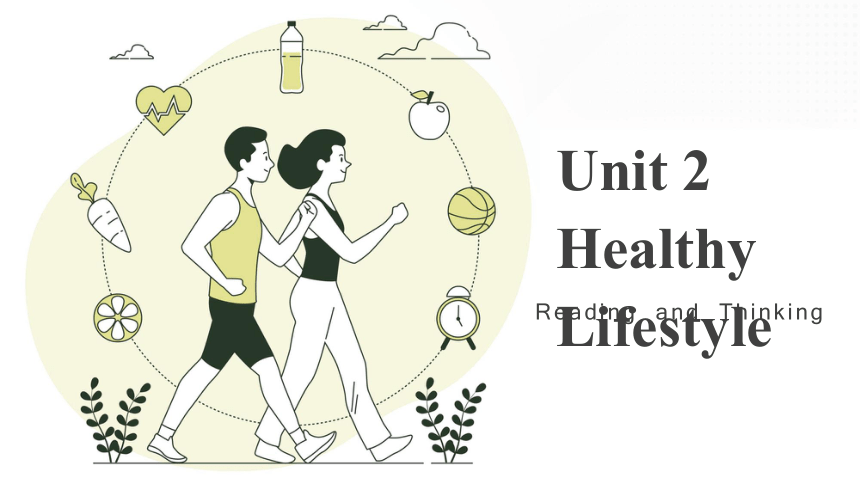
|
|
| 格式 | pptx | ||
| 文件大小 | 20.9MB | ||
| 资源类型 | 教案 | ||
| 版本资源 | 人教版(2019) | ||
| 科目 | 英语 | ||
| 更新时间 | 2024-12-26 15:28:57 | ||
图片预览

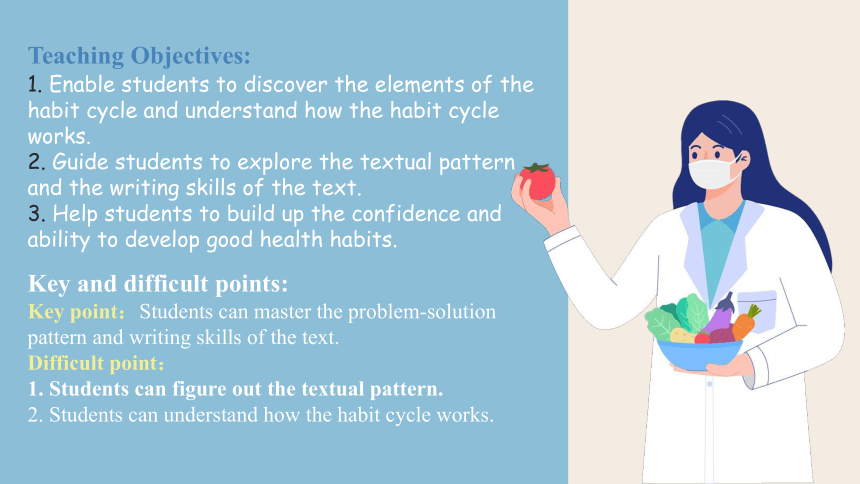
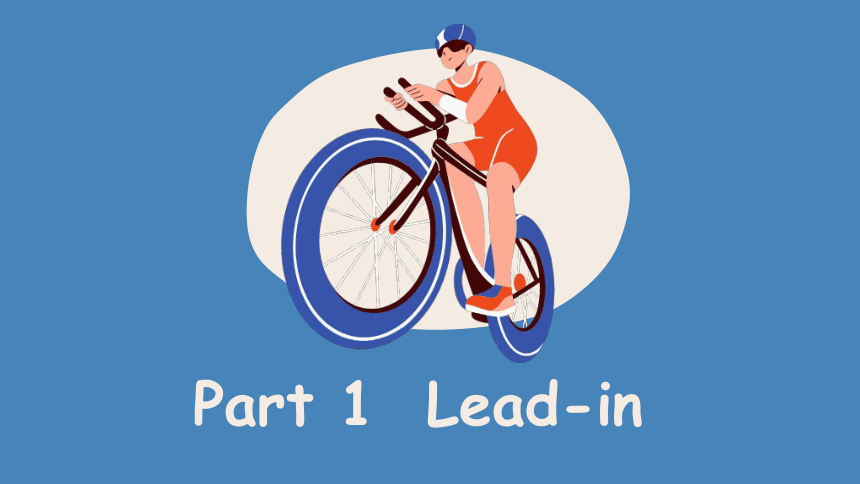
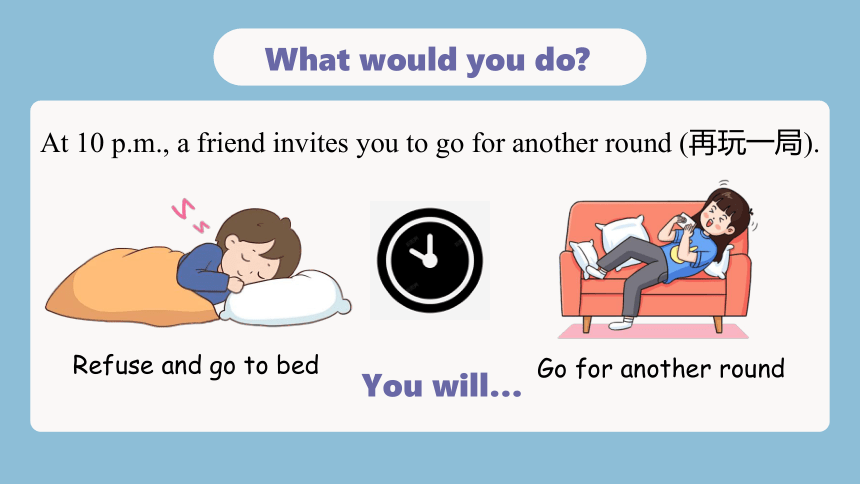
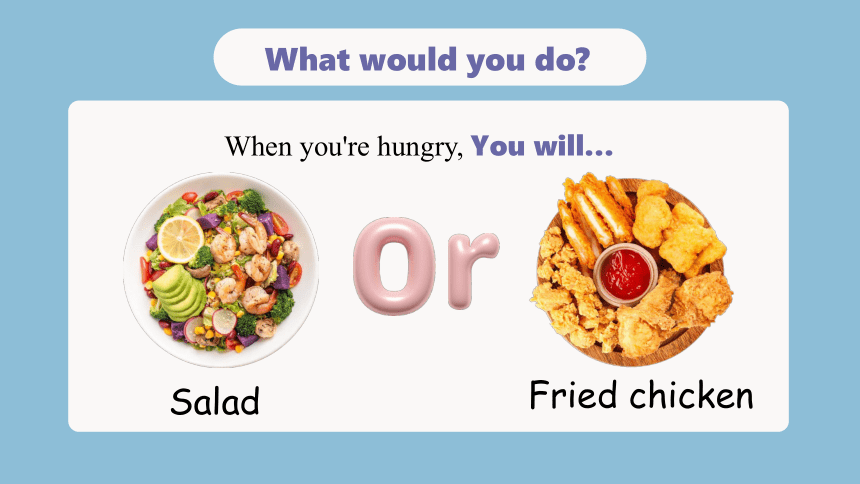
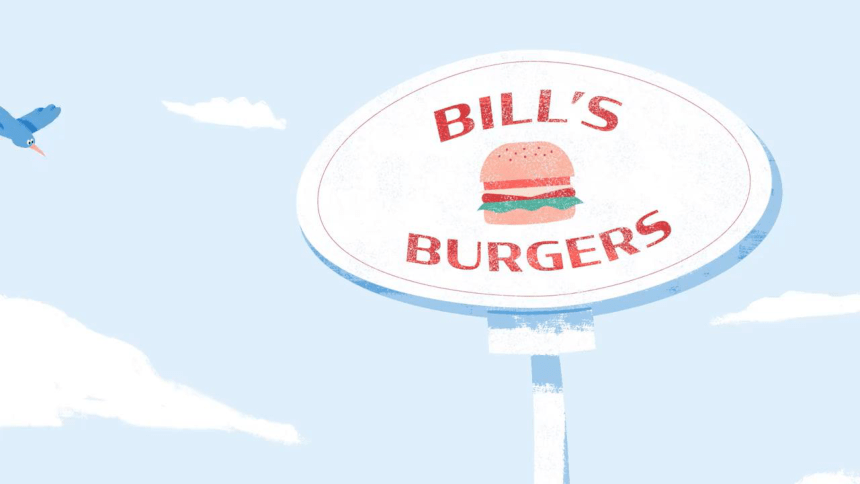
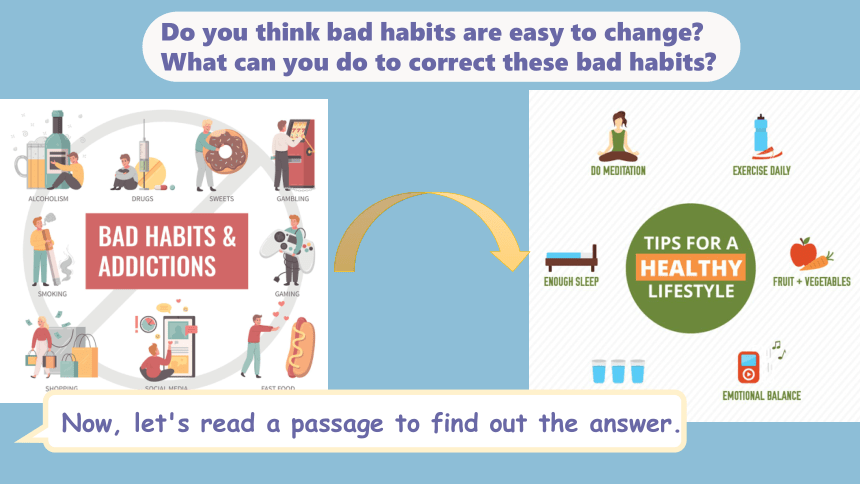
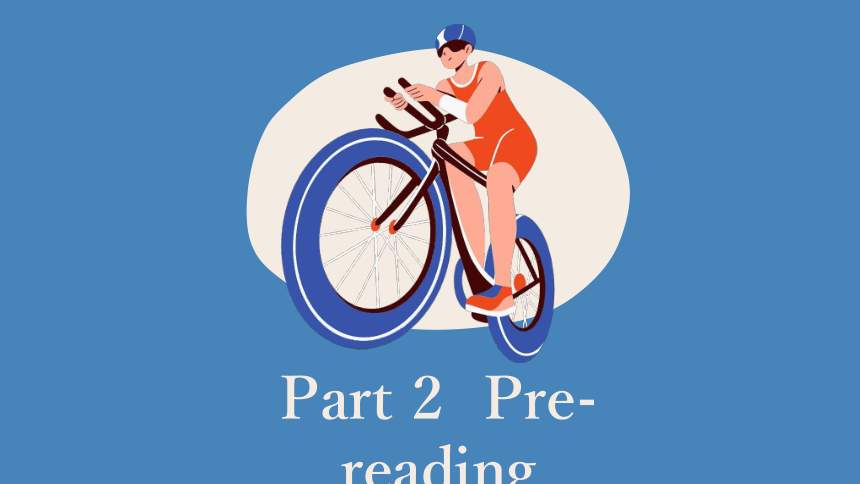
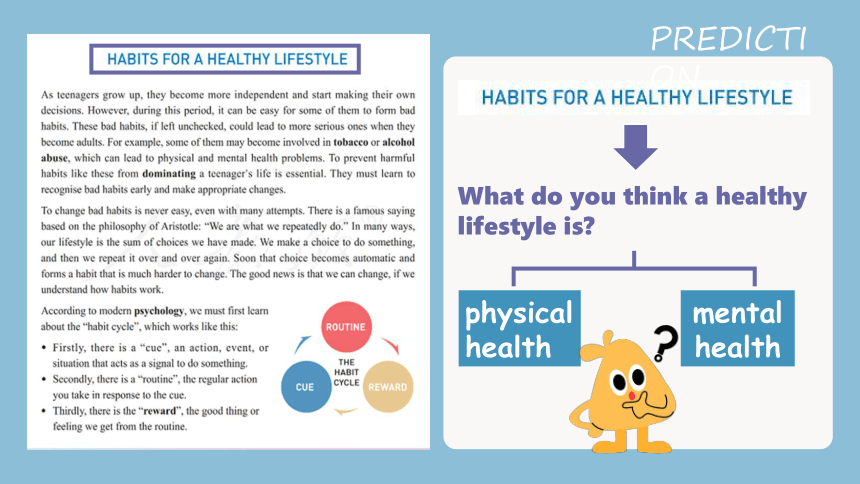
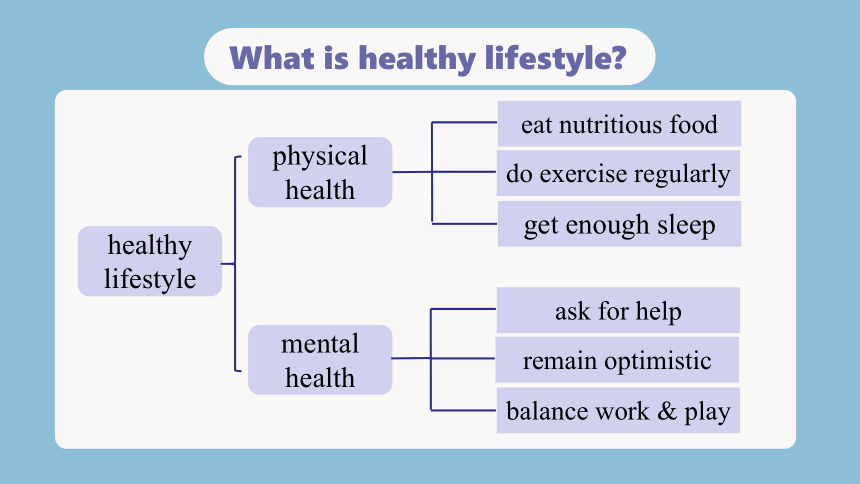
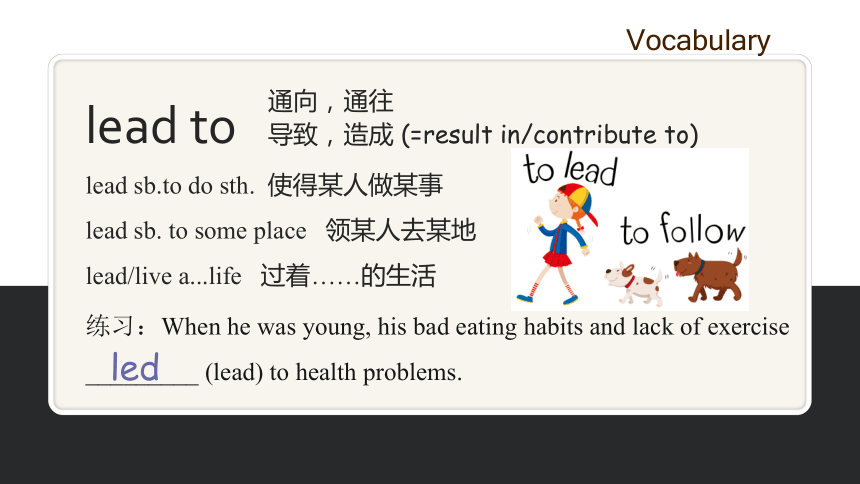
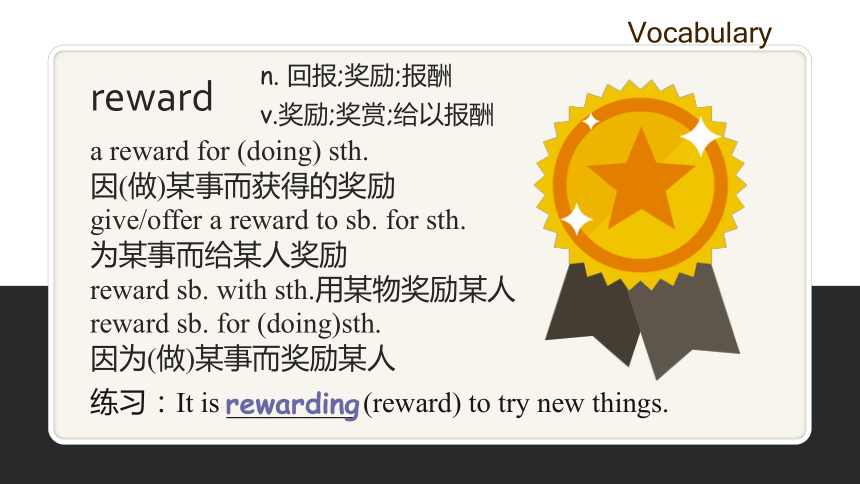
文档简介
(共37张PPT)
Unit 2
Healthy Lifestyle
Reading and Thinking
Teaching Objectives:
1. Enable students to discover the elements of the habit cycle and understand how the habit cycle works.
2. Guide students to explore the textual pattern and the writing skills of the text.
3. Help students to build up the confidence and ability to develop good health habits.
Key and difficult points:
Key point:Students can master the problem-solution pattern and writing skills of the text.
Difficult point:
1. Students can figure out the textual pattern.
2. Students can understand how the habit cycle works.
Part 1 Lead-in
What would you do
At 10 p.m., a friend invites you to go for another round (再玩一局).
You will…
Refuse and go to bed
Go for another round
What would you do
When you're hungry, You will…
Salad
Fried chicken
Do you think bad habits are easy to change
What can you do to correct these bad habits
Now, let's read a passage to find out the answer.
Part 2 Pre-reading
What do you think a healthy lifestyle is
PREDICTION
physical health
mental health
What is healthy lifestyle
healthy lifestyle
physical health
mental health
eat nutritious food
do exercise regularly
get enough sleep
ask for help
remain optimistic
balance work & play
Vocabulary
lead to
lead sb.to do sth. 使得某人做某事
lead sb. to some place 领某人去某地
lead/live a...life 过着……的生活
导致,造成 (=result in/contribute to)
练习:When he was young, his bad eating habits and lack of exercise _________ (lead) to health problems.
led
通向,通往
Vocabulary
reward
a reward for (doing) sth.
因(做)某事而获得的奖励
give/offer a reward to sb. for sth.
为某事而给某人奖励
reward sb. with sth.用某物奖励某人
reward sb. for (doing)sth.
因为(做)某事而奖励某人
n. 回报;奖励;报酬
v.奖励;奖赏;给以报酬
练习:It is _________ (reward) to try new things.
rewarding
Part 3 While-reading
Skim the title and the passage quickly.
A. Narration.
B. Exposition.
C. Argumentation.
What is text type of the passage
Who are the target audience of the text and what is the purpose of the author's writing the passage
Teenagers, especially those who want to change bad habits.
To introduce how habits are formed and how to change bad habits and create new ones.
Read the text and find out the topic sentence of each paragraph.
Find out the problem
Analyze the problem
Solve the problem
Conclusion
Read the text and find out the topic sentence of each paragraph.
Read the text and find out what main ideas are included in it. Tick the correct ones.
Critical thinking
1. What does the author intend to do in the first paragraph
A. Introduce the topic in this text.
B. Show us how to change our bad habits.
C. Give us two examples in our life.
D. Tell us not to take drugs.
Critical thinking
2. The key to changing our bad habits is ________ .
A. the three steps of habit formation.
B. the importance of a good habit
C. forming the right routine for people
D. understanding how habits work
Critical thinking
3. The author gives many examples in this text to ________.
A. show his/her wide knowledge
B. support his topics
C. persuade the readers to read more
D. call on us to take care of our children
Critical thinking
4. Through the given examples in the text, you will feel it easy for you to ________.
A. change your bad habits
B. understand other people
C. grasp the author’s ideas
D. form a good habit
Critical thinking
5. The author writes this text to ________.
A. tell us the long way to a good habit
B. show us how to break our bad habits
C. give us some tips in our daily life
D. remind us of the bad effect of habits
Reading for details
Para.1
As teenagers grow up, they become more independent and start making their own decisions. However, during this period, it can be easy for some of them to form bad habits. These bad habits, if left unchecked, could lead to more serious ones when they become adults. For example some of them may become involved in tobacco or alcohol abuse, which can lead to physical and mental health problems. To prevent harmful habits like these from dominating a teenager's life is essential. They must learn to recognise bad habits early and make appropriate changes.
How does the author develop the paragraph
start with a fact
state an opinion
By giving an example
Change
As teenagers grow up, they become more independent and start making their own decisions.
However, during this period, it can be easy for some of them to form bad habits. These bad habits, if left unchecked, could lead to more serious ones when they become adults.
For example some of them may become involved in tobacco or alcohol abuse, which can lead to physical and mental health problems.
Reading for details
Para.2
To change bad habits is never easy, even with many attempts. There is a famous saying based on the philosophy of Aristotle: "We are what we repeatedly do." In many ways, our lifestyle is the sum of choices we have made. We make a choice to do something, and then we repeat it over and over again. Soon that choice becomes automatic and forms a habit that is much harder to change. The good news is that we can change, if we understand how habits work.
How does the author develop the paragraph
By citing a quotation
There is a famous saying based on the philosophy of Aristotle: "We are what we repeatedly do."
Q1: What characteristics does a habit have
Q2: Why is it hard to change a habit
Because we usually don’t understand how habit works.
repetition
automatic
harder to change
Reading for details
Para.3
According to modern psychology, we must first learn about the "habit cycle", which works like this:
Firstly, there is "cue", an action, event, or situation that acts as a signal to do something.
Secondly, there is a "routine", the regular action you take in response to the cue.
Thirdly, there is a "reward", the good thing or feeling we get from the routine.
For example, when we feel unhappy (cue), we eat lots of unhealthy snacks (routine), which makes us feel happy (reward) The reward makes us much more likely to continue the cycle, and the bad habit of relying on unhealthy snacks is formed.
Q1:What are the three stages of habit cycle
Q2: How does the author further explain the "habit cycle"
cue
routine
reward
Firstly, there is "cue"...
Secondly, there is a "routine"...
Thirdly, there is a "reward",....
Make it more logical
By giving an example
For example, when we feel unhappy ...
Make it more convincing
Reading for details
Para.4
To facilitate a positive change in our bad habits, we must first examine our bad habit cycles and then try to adapt them. We can do this by combining the information from our habit cycles with our own positive ideas. For example, we could try to replace a negative routine with something more positive. So, when we feel unhappy again (cue), rather than eat snacks, we could listen to some of our favourite music instead (routine), which will make us feel relaxed (reward). Aside from changing bad habits, we can also use the habit cycle to create good habits. For example, when we come to an escalator(cue), our normal routine is to ride it, but we could change this routine into something more positive by taking the stairs instead.
Q1: What’s the author’s opinion How do you know that
Read to work out the author’s opinion on the application of the habit cycle.
“Aside from changing bad habits, we can also use the habit cycle to create good ones.”
Q2: What’s the function of the above sentence
It concludes the former information and introduces the following.
Reading for details
Para.5
Many of us try to change bad habits quickly and if we are not successful straight away, we often become pessimistic and give up. In fact, the most successful way to change is not suddenly, but over a period of time. As the Chinese philosopher Lao Zi wrote, "A journey of a thousand miles begins with a single step. "One step seems small, but it is essential. To reach the goal of change, a person must show some discipline and repeatedly take many small steps. After all, it is not easy to break bad habits .
Q1: With the habit cycle, do you think bad habits can be changed right away
How does the author develop the paragraph
By citing a quotation
As the Chinese philosopher Lao Zi wrote, "A journey of a thousand miles begins with a single step. "
Reading for details
Para.6
For young people, there is plenty of time to change bad habits. However, there is no "magic pill" or delete button that will help you; you have to think about your bad habits and decide on some changes. You have the power to build a happy and healthy life full of good habits!
Q. What is this paragraph mainly about
What is the writing purpose Work in pairs and figure it out.
to appeal to young people including teenagers to change bad habits and live a happy and healthy life
Part 4 Post-reading
Summarizing
HABITS FOR A HEALTHY LIFESTYLE
Exposition
Raise the problem
Analyse the problem
Solve the problem
Draw a conclusion
(Para.1) It is essential to prevent bad habits from dominating a teenager's life.
(Para.2-3) A choice becomes automatic and forms a habit if repeated over and over again.
(Para.4-5) What should we do to change a bad habit
(Para.6) It is not easy to change a bad habit.
Post-reading
1.What kind of attitude does the author hold to changing bad habits
A.Negative. B.Sad.
C.Doubtful. D.Positive.
2.Who are the target audience of the text
Teenagers, especially those who want to change bad habits.
3.To change a bad habit,we need ________.
A.time B.discipline
C.repeated small steps D.all of above
Language learning
养成坏习惯
认清不良习惯
置之不理
开始过度吸烟/饮酒
造成身心健康问题
再三重复
习惯循环
作为对信号的回应
除了……外还
惯常行为
立刻,马上
很多时间
主宰青少年的生活
促成积极的改变
form bad habits
recognize bad habits
leave unchecked
become involved in tobacco/alcohol abuse
lead to physical and mental health problems/issues
repeat it over and over again
habit cycle
in response to the cue
aside/apart from
normal routine
straight away
plenty of time
dominate a teenager's life
facilitate a positive change
Part 5 Language Points
Language points
There is a famous saying based on the philosophy of Aristotle: “We are what we repeatedly do.”
based on在句中是过去分词短语作后置定语,放在被修饰的名词后面,它的作用相当于一个定语从句。
1. 过去分词作定语时,过去分词所表示的动作可以在谓语所表示的动作之前发生,也可以没有一定的时间性。
2. 作定语的现在分词所表示正在进行的动作(变为从句时要用进行时态),或表示经常性的动作,或现在(或当时)的状态(变为从句时, 用一般时态)。
Tell the children playing there (= who are playing there) not to make so much noise.
The living room has a broad bay window facing (= that faces) the street.
Language points
So, when we feel unhappy again (cue), rather than eat snacks, we could listen to some of our favourite music instead (routine), which will make us feel relaxed (reward).
rather than 后接不定式时,不定式可以带 to,也可以不带 to。但当rather than 位于句首时,则只能接不带 to 的不定式。
rather than 连接的并列成分可以是名词、代词、形容词、介词短语、动名词、分词、不定式及动词等。rather than 连接两个名词或代词作主语时,谓语动词应与 rather than 前面的名词或代词在人称和数上保持一致
It was the culture, rather than the language, that made it hard for him to adapt to the new environment abroad.
是文化而不是语言使他难以适应国外的新环境。(强调句)
Language points
...you have to think about your bad habits and decide on some changes.
……你必须思考自己的不良习惯,选定一些作出改变。
decide on 决定;选定(= decide upon)
It is freezing cold outside. Have you decided on going back home on foot
外面非常冷。你已决定步行回家了吗
We have decided on a proper place for the household to live in.
我们已选定一个合适的地方让这家人住。
“做出决定”的各种表达:
decide/determine to do sth.
决定做某事(动作)
be determined to do sth
决定做某事(状态)
make a decision
做出决定
SEE YOU NEXT TIME
Unit 2
Healthy Lifestyle
Reading and Thinking
Teaching Objectives:
1. Enable students to discover the elements of the habit cycle and understand how the habit cycle works.
2. Guide students to explore the textual pattern and the writing skills of the text.
3. Help students to build up the confidence and ability to develop good health habits.
Key and difficult points:
Key point:Students can master the problem-solution pattern and writing skills of the text.
Difficult point:
1. Students can figure out the textual pattern.
2. Students can understand how the habit cycle works.
Part 1 Lead-in
What would you do
At 10 p.m., a friend invites you to go for another round (再玩一局).
You will…
Refuse and go to bed
Go for another round
What would you do
When you're hungry, You will…
Salad
Fried chicken
Do you think bad habits are easy to change
What can you do to correct these bad habits
Now, let's read a passage to find out the answer.
Part 2 Pre-reading
What do you think a healthy lifestyle is
PREDICTION
physical health
mental health
What is healthy lifestyle
healthy lifestyle
physical health
mental health
eat nutritious food
do exercise regularly
get enough sleep
ask for help
remain optimistic
balance work & play
Vocabulary
lead to
lead sb.to do sth. 使得某人做某事
lead sb. to some place 领某人去某地
lead/live a...life 过着……的生活
导致,造成 (=result in/contribute to)
练习:When he was young, his bad eating habits and lack of exercise _________ (lead) to health problems.
led
通向,通往
Vocabulary
reward
a reward for (doing) sth.
因(做)某事而获得的奖励
give/offer a reward to sb. for sth.
为某事而给某人奖励
reward sb. with sth.用某物奖励某人
reward sb. for (doing)sth.
因为(做)某事而奖励某人
n. 回报;奖励;报酬
v.奖励;奖赏;给以报酬
练习:It is _________ (reward) to try new things.
rewarding
Part 3 While-reading
Skim the title and the passage quickly.
A. Narration.
B. Exposition.
C. Argumentation.
What is text type of the passage
Who are the target audience of the text and what is the purpose of the author's writing the passage
Teenagers, especially those who want to change bad habits.
To introduce how habits are formed and how to change bad habits and create new ones.
Read the text and find out the topic sentence of each paragraph.
Find out the problem
Analyze the problem
Solve the problem
Conclusion
Read the text and find out the topic sentence of each paragraph.
Read the text and find out what main ideas are included in it. Tick the correct ones.
Critical thinking
1. What does the author intend to do in the first paragraph
A. Introduce the topic in this text.
B. Show us how to change our bad habits.
C. Give us two examples in our life.
D. Tell us not to take drugs.
Critical thinking
2. The key to changing our bad habits is ________ .
A. the three steps of habit formation.
B. the importance of a good habit
C. forming the right routine for people
D. understanding how habits work
Critical thinking
3. The author gives many examples in this text to ________.
A. show his/her wide knowledge
B. support his topics
C. persuade the readers to read more
D. call on us to take care of our children
Critical thinking
4. Through the given examples in the text, you will feel it easy for you to ________.
A. change your bad habits
B. understand other people
C. grasp the author’s ideas
D. form a good habit
Critical thinking
5. The author writes this text to ________.
A. tell us the long way to a good habit
B. show us how to break our bad habits
C. give us some tips in our daily life
D. remind us of the bad effect of habits
Reading for details
Para.1
As teenagers grow up, they become more independent and start making their own decisions. However, during this period, it can be easy for some of them to form bad habits. These bad habits, if left unchecked, could lead to more serious ones when they become adults. For example some of them may become involved in tobacco or alcohol abuse, which can lead to physical and mental health problems. To prevent harmful habits like these from dominating a teenager's life is essential. They must learn to recognise bad habits early and make appropriate changes.
How does the author develop the paragraph
start with a fact
state an opinion
By giving an example
Change
As teenagers grow up, they become more independent and start making their own decisions.
However, during this period, it can be easy for some of them to form bad habits. These bad habits, if left unchecked, could lead to more serious ones when they become adults.
For example some of them may become involved in tobacco or alcohol abuse, which can lead to physical and mental health problems.
Reading for details
Para.2
To change bad habits is never easy, even with many attempts. There is a famous saying based on the philosophy of Aristotle: "We are what we repeatedly do." In many ways, our lifestyle is the sum of choices we have made. We make a choice to do something, and then we repeat it over and over again. Soon that choice becomes automatic and forms a habit that is much harder to change. The good news is that we can change, if we understand how habits work.
How does the author develop the paragraph
By citing a quotation
There is a famous saying based on the philosophy of Aristotle: "We are what we repeatedly do."
Q1: What characteristics does a habit have
Q2: Why is it hard to change a habit
Because we usually don’t understand how habit works.
repetition
automatic
harder to change
Reading for details
Para.3
According to modern psychology, we must first learn about the "habit cycle", which works like this:
Firstly, there is "cue", an action, event, or situation that acts as a signal to do something.
Secondly, there is a "routine", the regular action you take in response to the cue.
Thirdly, there is a "reward", the good thing or feeling we get from the routine.
For example, when we feel unhappy (cue), we eat lots of unhealthy snacks (routine), which makes us feel happy (reward) The reward makes us much more likely to continue the cycle, and the bad habit of relying on unhealthy snacks is formed.
Q1:What are the three stages of habit cycle
Q2: How does the author further explain the "habit cycle"
cue
routine
reward
Firstly, there is "cue"...
Secondly, there is a "routine"...
Thirdly, there is a "reward",....
Make it more logical
By giving an example
For example, when we feel unhappy ...
Make it more convincing
Reading for details
Para.4
To facilitate a positive change in our bad habits, we must first examine our bad habit cycles and then try to adapt them. We can do this by combining the information from our habit cycles with our own positive ideas. For example, we could try to replace a negative routine with something more positive. So, when we feel unhappy again (cue), rather than eat snacks, we could listen to some of our favourite music instead (routine), which will make us feel relaxed (reward). Aside from changing bad habits, we can also use the habit cycle to create good habits. For example, when we come to an escalator(cue), our normal routine is to ride it, but we could change this routine into something more positive by taking the stairs instead.
Q1: What’s the author’s opinion How do you know that
Read to work out the author’s opinion on the application of the habit cycle.
“Aside from changing bad habits, we can also use the habit cycle to create good ones.”
Q2: What’s the function of the above sentence
It concludes the former information and introduces the following.
Reading for details
Para.5
Many of us try to change bad habits quickly and if we are not successful straight away, we often become pessimistic and give up. In fact, the most successful way to change is not suddenly, but over a period of time. As the Chinese philosopher Lao Zi wrote, "A journey of a thousand miles begins with a single step. "One step seems small, but it is essential. To reach the goal of change, a person must show some discipline and repeatedly take many small steps. After all, it is not easy to break bad habits .
Q1: With the habit cycle, do you think bad habits can be changed right away
How does the author develop the paragraph
By citing a quotation
As the Chinese philosopher Lao Zi wrote, "A journey of a thousand miles begins with a single step. "
Reading for details
Para.6
For young people, there is plenty of time to change bad habits. However, there is no "magic pill" or delete button that will help you; you have to think about your bad habits and decide on some changes. You have the power to build a happy and healthy life full of good habits!
Q. What is this paragraph mainly about
What is the writing purpose Work in pairs and figure it out.
to appeal to young people including teenagers to change bad habits and live a happy and healthy life
Part 4 Post-reading
Summarizing
HABITS FOR A HEALTHY LIFESTYLE
Exposition
Raise the problem
Analyse the problem
Solve the problem
Draw a conclusion
(Para.1) It is essential to prevent bad habits from dominating a teenager's life.
(Para.2-3) A choice becomes automatic and forms a habit if repeated over and over again.
(Para.4-5) What should we do to change a bad habit
(Para.6) It is not easy to change a bad habit.
Post-reading
1.What kind of attitude does the author hold to changing bad habits
A.Negative. B.Sad.
C.Doubtful. D.Positive.
2.Who are the target audience of the text
Teenagers, especially those who want to change bad habits.
3.To change a bad habit,we need ________.
A.time B.discipline
C.repeated small steps D.all of above
Language learning
养成坏习惯
认清不良习惯
置之不理
开始过度吸烟/饮酒
造成身心健康问题
再三重复
习惯循环
作为对信号的回应
除了……外还
惯常行为
立刻,马上
很多时间
主宰青少年的生活
促成积极的改变
form bad habits
recognize bad habits
leave unchecked
become involved in tobacco/alcohol abuse
lead to physical and mental health problems/issues
repeat it over and over again
habit cycle
in response to the cue
aside/apart from
normal routine
straight away
plenty of time
dominate a teenager's life
facilitate a positive change
Part 5 Language Points
Language points
There is a famous saying based on the philosophy of Aristotle: “We are what we repeatedly do.”
based on在句中是过去分词短语作后置定语,放在被修饰的名词后面,它的作用相当于一个定语从句。
1. 过去分词作定语时,过去分词所表示的动作可以在谓语所表示的动作之前发生,也可以没有一定的时间性。
2. 作定语的现在分词所表示正在进行的动作(变为从句时要用进行时态),或表示经常性的动作,或现在(或当时)的状态(变为从句时, 用一般时态)。
Tell the children playing there (= who are playing there) not to make so much noise.
The living room has a broad bay window facing (= that faces) the street.
Language points
So, when we feel unhappy again (cue), rather than eat snacks, we could listen to some of our favourite music instead (routine), which will make us feel relaxed (reward).
rather than 后接不定式时,不定式可以带 to,也可以不带 to。但当rather than 位于句首时,则只能接不带 to 的不定式。
rather than 连接的并列成分可以是名词、代词、形容词、介词短语、动名词、分词、不定式及动词等。rather than 连接两个名词或代词作主语时,谓语动词应与 rather than 前面的名词或代词在人称和数上保持一致
It was the culture, rather than the language, that made it hard for him to adapt to the new environment abroad.
是文化而不是语言使他难以适应国外的新环境。(强调句)
Language points
...you have to think about your bad habits and decide on some changes.
……你必须思考自己的不良习惯,选定一些作出改变。
decide on 决定;选定(= decide upon)
It is freezing cold outside. Have you decided on going back home on foot
外面非常冷。你已决定步行回家了吗
We have decided on a proper place for the household to live in.
我们已选定一个合适的地方让这家人住。
“做出决定”的各种表达:
decide/determine to do sth.
决定做某事(动作)
be determined to do sth
决定做某事(状态)
make a decision
做出决定
SEE YOU NEXT TIME
